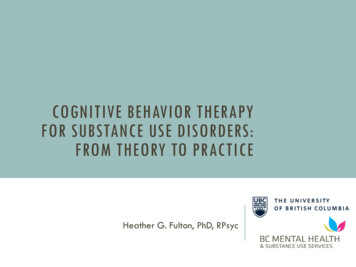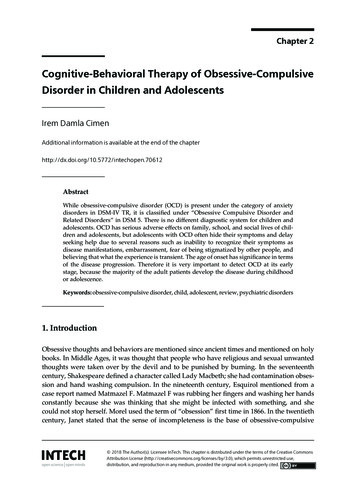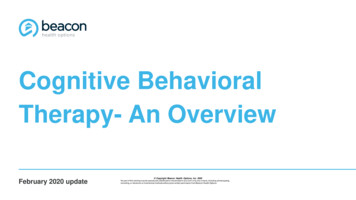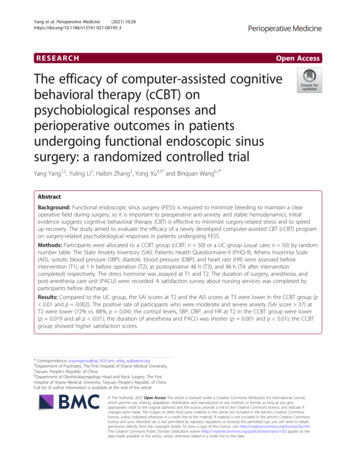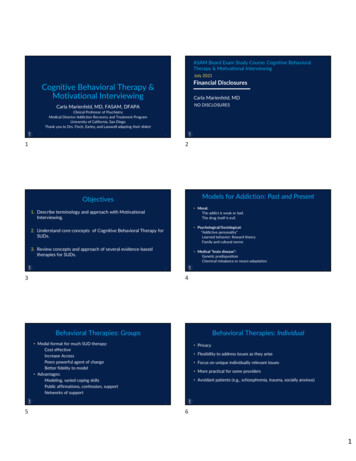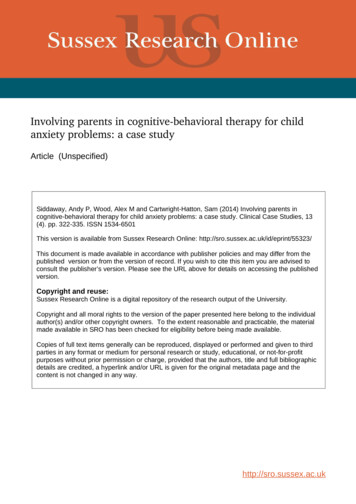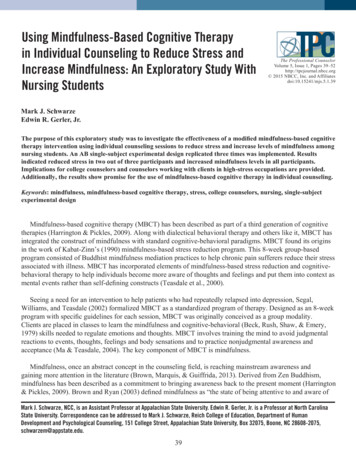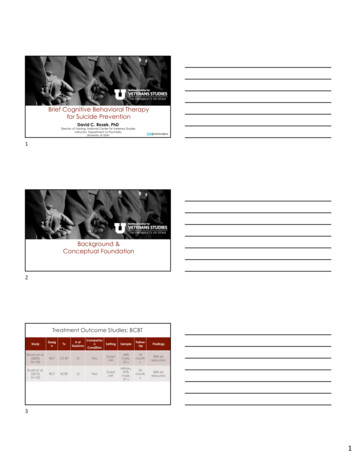
Transcription
Brief Cognitive Behavioral Therapyfor Suicide PreventionDavid C. Rozek, PhDDirector of Training, National Center for Veterans StudiesInstructor, Department of PsychiatryUniversity of Utah11Background &Conceptual Foundation22Treatment Outcome Studies: BCBTStudyDesignTx# pFindingsBrown et al.(2005)N 120RCTCT-SP10TAUOutptMH40%male,35 y18months50% rel.reductionRudd et al.(2015)N 152RCTBCBT12TAUOutptMHMilitary,87%male,27 y24months60% rel.reduction31
BCBT Outcomes: Suicide AttemptsBCBT associated with 60% reduction insuicide attemptsRudd et al. (2015)44BCBT Outcomes: Suicide Ideation &HopelessnessBCBT and TAUcomparable on suicideideation andhopelessnessRudd et al. (2015)55BCBT Outcomes: Depression, Anxiety, PTSDBCBT and TAUcomparable ondepression andanxietyBCBT slightly betterthan TAU for PTSDsymptoms, butstatisticallynonsignificantRudd et al. (2015)662
BCBT Outcomes: Treatment UtilizationMean number of BCBTsessions was 12BCBT associated with moreindividual therapy sessionsduring first 3 monthsBCBT associated with fewerhospitalization days overentire study periodRudd et al. (2015)7(Rudd et al., 2015)7Conceptualizing Suicide Risk88Functional Model of rnal)PositiveNegativeAdding somethingdesirableReducing tension ornegative affect(“To feel something, even if it is pain”)(“To stop bad feelings”)Gaining something fromothersEscape interpersonaltask demands(“To get attention or let others knowhow I feel”)(“To avoid punishment from others oravoid doing something undesirable”)Nock & Prinstein (2005)993
The Suicidal itive flexibilityProblem solving“This is hopeless”“I’m trapped”“I’m a burden”EmotionalBehavioralPrior attemptsEmotion regulationInterpersonal skillsBehavioralPsychiatric disorderEmotional labilityHPA axis.EmotionalSubstance useSocial ngEventsPhysicalGeneticsMedical nRelationship problemFinancial stressPerceived lossPhysical sensationNegative memoriesBryan & Rudd (2018)1010The Suicidal ModeStableDynamicCognitive“This is hopeless”“I’m trapped”“I’m a tance useSocial ngEventsRelationship problemFinancial stressPerceived lossPhysical sensationNegative niaPainBryan & Rudd (2018)1111Fluid Vulnerability Theory1098Suicide Risk76543210Multiple AttempterNon-multiple attempter12Bryan & Rudd (2016)124
Core Principles of Treatment withSuicidal Patients1313The Language of Suicide1. Remove pejorative language2. Improve consistency of documentation3. Improve communication between clinicians4. Improve accuracy of risk assessments5. Improve clinical decision-making6. Improve treatment outcomes1414The Language of SuicideSuicide attemptNonsuicidal self-injuryA nonfatal, self-directed,potentially injurious behavior withany intent to die as a result of thebehavior. A suicide attempt mayor may not result in injury.Behavior that is self-directed anddeliberately results in injury or thepotential for injury to oneself. Thereis no evidence, whether implicit orexplicit, of suicidal intent.Crosby et al. (2011)15155
Clinician vs. Patient GoalsClinicianPatientprevent deathdon’t get suedalleviate sufferingsolve the problem1616Suicide Risk AssessmentDomainExamplesBaseline Risk FactorsPrior Suicide AttemptsHistory of Psychiatry DisordersActivating EventsRelationship ProblemsFinancial StrainSymptoms (Emotional & Physical)DepressionGuiltSuicide-Specific Beliefs (Cognitive)HopelessnessPerceived BurdensomenessImpulse Control & Dysregulation (Behavioral)Nonsuicidal Self-InjuryAlcohol UseProtective FactorsReasons for LivingHopeBryan & Rudd (2006)1717Dimensions of Suicidal ThinkingResolved PlanningSuicidal DesireSense of courageAvailability of suicide meansOpportunity to attempt suicideSpecificity of suicide planHigh duration & high intensityideationNo reasons for livingWish to dieHigh frequency ideationDesire and expectancy to dieLack of deterrentsJoiner, Rudd, & Hasan (1997)18186
Overview of Treatment1919Structure of BCBTPhase IPhase IIPhase IIIEmotion RegulationCognitive FlexibilityRelapse PreventionSession 1IntakeNarrative Risk AssessmentCrisis Response PlanMeans Safety CounselingSessions 6-10ABC WorksheetsChallenging QuestionsPatterns of Problem ThinkingActivity PlanningCoping CardsSessions 11-12Relapse Prevention TaskSessions 2-5Treatment PlanSleep DisturbanceRelaxation / MindfulnessReasons for LivingSurvival Kit2020General Structure of BCBT Session1. Review assignments and bridge from previous session– Crisis response plan– Homework assignments2. Introduce new skill or intervention– Verbally describe the skill– Explicitly connect the skill to the suicidal mode3. Demonstrate and practice the skill– Discuss patient’s experience– Develop plan for practice and address potential barriers4. Enter lesson learned into treatment log21217
Defining Treatment CompletionTreatment is terminated when patient demonstrates acquisition ofemotion regulation and cognitive flexibility skills, typicallyindicated via use of crisis response plan and other BCBT skillsRelapse prevention task serves as final competency checkIf patient is unable to effectively complete relapse preventiontask, continue therapy until mastery is achieved2222The First Session2323Setting the Stage1. Describe cognitive behavioral session structure2. Describe the phased structure of BCBT3. Discuss confidentiality and limits to confidentiality4. Discuss potential role of family members5. Assess patient comprehension and invite questions24248
Narrative Assessment vs. Traditional InterviewNarrative AssessmentTraditional Interview AssessmentHigher empathy ratingsHigher affective synchronyEmotional co-regulationLower speech complexityLower empathy ratingsLower affective synchronyEmotional co-dysregulationGreater speech complexity2525Narrative Assessment1. Invite the patient to tell his or her story of the index suicidalepisode– “Let’s talk about your suicide attempt/what’s been going on lately.”– “Can you tell me the story of what happened?”2. Assist the patient in identifying and describing sequence of events– “What happened next?”– “And then what happened?”– “What were you saying to yourself at that point?”– “Did you notice any sensations in your body at that point?”3. Provide emotional validation2626The Suicidal ModeStableDynamicCognitive“This is hopeless”“I’m trapped”“I’m a ance useSocial ingEventsRelationship problemFinancial stressPerceived lossPhysical sensationNegative niaPainBryan & Rudd (2018)27279
Treatment Log & Case Conceptualization1. Introduce the treatment log2. Enhance motivation to keepthe treatment log3. Collaboratively review thesuicidal mode2828Crisis Response Plan1. Explain rationale for CRP2. Provide card for patient to record CRP3.4.5.6.7.Identify personal warning signsIdentify self-management strategiesIdentify reasons for livingIdentify social supportsProvide crisis / emergency steps8. Verbally review and rate likelihood of use2929Sample Crisis Response Plans3010
Phase I:Emotion Regulation3131Treatment Planning1. Explain the rationale for atreatment plan2. Prioritize suicide risk3. Identify and collaborativelyestablish additional treatmentgoals3232Commitment to Treatment Statement333311
Means Safety CounselingPhaseContent1. EngagingRaise the issue of suicide means (e.g., firearms) and invitethe patient to share his or her initial thoughts.2. FocusingIntroduce the topic of safety and invite the patient toshare his or her existing safety procedures.3. EvokingAsk open-ended questions to encourage furtherdiscussion about commitment to safety.4. PlanningAssist the patient in developing a concrete plan ofaction for temporarily limiting his or her access topotentially lethal meansBritton, Bryan, & Valenstein (2015)34343535Targeting Sleep Disturbance363612
Relaxation and Mindfulness Skills TrainingRelaxationMindfulnessFocuses on reducing physiologicalindicators (e.g., muscle tension) ofheightened autonomic arousalFocuses on reducing ruminationand cognitive-affective reactivitywhile increasing perspectivetaking3737Reasons for Living List1. Introduce the concept of reasons for living2. Identify the patient’s reasons for living3. Increase the emotional salience of these reasons for living– Tell me more about that.– What do you find so enjoyable about that?– Why is that person so important to you?4. Write the reasons for living on an index card3838Survival Kit1. Introduce the concept of the survival kit2. Review the content of the survival kit at the next session– Tell me more about this item.– Why did you decide to include this item?– When you think of this item, what happens to your emotions?3. Identify a location for keeping the survival kit393913
Phase II:Cognitive Flexibility4040Adapted from Cognitive Processing Therapy for PTSD: A Comprehensive Manual by PA Resick, CM Monson, and KM Chard4141Adapted from Cognitive Processing Therapy for PTSD: A Comprehensive Manual by PA Resick, CM Monson, and KM Chard424214
Adapted from Cognitive Processing Therapy for PTSD: A Comprehensive Manual by PA Resick, CM Monson, and KM Chard4343Activity Planning1. Introduce the concept of activity planning2. Identify pleasurable activities3. Develop a specific plan for engaging in the activity–––––––How often do you currently do this activity?How often would you like to do this activity?When would you be able to start this activity?How long do you think you would be able to do this activity?Where will you do this activity?When will you do this activity?Is there anything you need to do to prepare for this activity?4444Coping Cards454515
Phase III:Relapse Prevention4646Relapse Prevention Task1. Ability to select a self-regulation skill that is relevant orappropriate to the situation2. Ability to select a self-regulation skill that is practical within theconstraints of the situation3. Ability to adapt in response to situational demands and/orunexpected contingencies4. Ability to rapidly select and implement skills4747Relapse Prevention Task1. Review the patient’s treatment log and crisis response plan2. Educate the patient about how the relapse prevention task willoccur and the potential for emotional distress3. Guide the patient through a relapse prevention task focusedon the original suicidal crisis or episode that promptedtreatment4. After completion, discuss the patient’s experience– How was that for you?– What did you notice while doing this?– What was easy and what was difficult?484816
The Final Session1. Review the patient’s treatment log and identify a final lessonlearned2. Educate the patient about follow-up procedures and providerecommendations for continuing care3. Discuss the patient’s preferences regarding posttreatmentcaring contacts4949Additional Resources5050Treatment ManualProvides step-by-step instructionsfor administering BCBT.515117
Additional ReadingProvides an overview of how thecentral concepts of BCBT havebeen adapted for use in differentsettings and populations.5252Additional ReadingProvides an overview of theCollaborative Assessment andManagement of Suicidality (CAMS),an assessment-based frameworkthat complements BCBT.5353Additional ReadingDownload copies of published articles focused on BCBT and the crisisresponse plan at www.veterans.utah.edu545418
Training VideosWatch training videos and demonstrations on our YouTube page. Searchfor “National Center for Veterans Studies”5555NATIONAL CENTERFOR VETERANS w.veterans.utah.edu/ Veterans Studies565619
Brief Cognitive Behavioral Therapy for Suicide Prevention 2 Background & Conceptual Foundation Treatment Outcome Studies: BCBT Study Desig n Tx # of Sessions Compariso n Condition Setting Sample Follow-Up Findings Brown et al. (2005) N 120 RCT CT-SP 10 TAU Outpt MH 40% male, 35 y 18 month s 50% rel. reduction Rudd et al. (2015) N 152 RCT BCBT .

